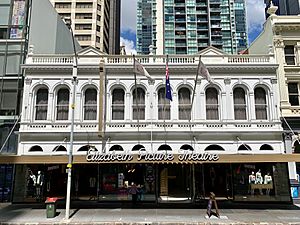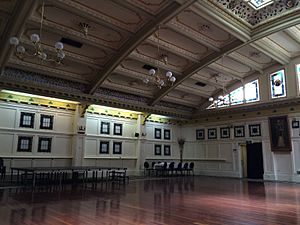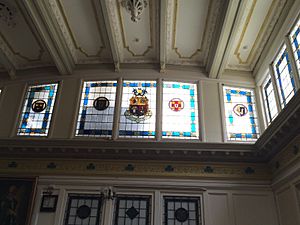Tara House facts for kids
Quick facts for kids Tara House |
|
|---|---|

Tara House (Irish Club), 2018
|
|
| Location | 179 Elizabeth Street, Brisbane City, City of Brisbane, Queensland, Australia |
| Design period | 1870s - 1890s (late 19th century) |
| Built | c. 1878 - 1928 |
| Built for | James Hunter (bootmaker) |
| Architect | Richard Gailey |
| Architectural style(s) | Classicism |
| Owner | James Peter Sourris, Stephen James Sourris and Peter James Sourris |
| Official name: Tara House (Irish Club) | |
| Type | state heritage (built) |
| Designated | 21 October 1992 |
| Reference no. | 600105 |
| Significant period | c. 1878, 1927-1928 (fabric) 1919 (historical) |
| Lua error in Module:Location_map at line 420: attempt to index field 'wikibase' (a nil value). | |
Tara House is a special building in Brisbane City, Queensland, Australia. It is located at 179 Elizabeth Street. A famous architect named Richard Gailey designed it. The building was constructed between about 1878 and 1928.
For a long time, from 1919 to 2015, it was known as the Irish Club. This club owned and used the building. Tara House is so important that it was added to the Queensland Heritage Register in 1992. Today, the building has been changed into a cinema complex called The Elizabeth Picture Theatre. The new owners, the Sourris brothers, have kept many of the original historical parts of the building.
Contents
The Story of Tara House
Early Days and Owners
The land where Tara House stands was bought in 1877 by James Hunter. He was a boot manufacturer, meaning he made and sold boots. Soon after, the architect Richard Gailey started looking for builders. He wanted to construct two large stores for James Hunter on Elizabeth Street.
By 1879, Hunter was offering his new warehouses for rent. This showed that more people were becoming interested in this area for businesses. From 1879 to 1884, two important businessmen, Theodore Unmack and Johann Christian Heussler, ran their business from the building.
Later, from 1884 to 1899, a rich merchant from London named Alexander McArthur owned the building. He used it as the Brisbane office for his large warehouse company. In 1899, James Cowlishaw became the new owner. He was an architect, owned a newspaper, and was involved in politics. During his time, different companies rented space in the building. These included importers and other warehouse businesses.
The Irish Club Era
In 1919, the Queensland Irish Association (QIA) bought the building. This group represents people of Irish background in Queensland. James Cowlishaw helped them buy it by lending them money. The QIA owned Tara House for a very long time, until 2015.
The success of the QIA shows how important the Irish community was in Queensland. In the 1860s, about 18% of Queensland's population was born in Ireland.
Tara House had many changes and repairs over the years. Major work was done inside the building in 1927-1928. This project was done by a well-known architecture firm called Cavanagh and Cavanagh. The changes inside were made to show the building's connection to Irish culture. This connection lasted for over seventy years. The building was officially named Tara House in a special ceremony on 28 June 1948.
Recent Changes
In February 2015, the Irish Club faced financial problems. They had borrowed a lot of money for renovations. The club tried to keep going but could not pay its debts. In May 2015, the club had to close down.
In June 2015, Tara House was put up for sale. This was so the Irish Club could pay back the money it owed. In November 2015, a local private investor bought the building for $8.1 million. On 16 December 2015, it was announced that the Queensland Irish Association could not rent space in Tara House anymore. Other businesses offered more money to rent the building.
In September 2016, a plan was made to turn Tara House into a cinema. This plan was put forward by James Peter Sourris, Stephen James Sourris, and Peter James Sourris. They had also changed another old cinema, the Village Twin Cinemas, into a new cinema complex. The plan for Tara House was approved in February 2017.
What Tara House Looks Like
Tara House is in a part of Elizabeth Street that used to be full of warehouses. It is near other old warehouse buildings, like the Heckelmanns Building. Today, this area has many shops and offices.
Tara House is a two-storey building with a basement. It is made of brick and covered in cement. It was built in the late 1870s. The building has simple classical details. The top floor has an arcade (a row of arches) with a decorative top part called an entablature. Above that is a fence-like structure called a balustraded parapet.
The arcade has two matching sections. Each section has five rounded arch openings. The middle arch in each section has columns on either side. Above this, on the roofline, is a triangular shape called a pediment. There are also decorative urns (vase-like shapes) on top of the building.
In 1927-1928, big changes were made to the building. The original back wall was removed. A new part made of strong concrete and steel was added. At the same time, the inside of the first floor was redesigned. The back half of this floor has a curved ceiling with decorative panels. It is decorated with plaster models of angels, harps, and Australian flowers in gold. The walls are covered in silky oak wood. The floor is made of hardwood.
There are special stained-glass panels in the ceiling and one wall. These panels show the four counties of Ireland and the Queensland coat of arms. Other stained-glass windows are on the north-east side wall.
The original look of the ground floor and its inside decorations have been removed. However, the upper floor still has its 1927-1928 decorations. Even though a bar, kitchen, and some false ceilings have been added. The basement has also been updated a lot.
Why Tara House is Special
Tara House (Irish Club) was added to the Queensland Heritage Register on 21 October 1992. This means it is a very important historical place.
Showing Queensland's History
Tara House helps us understand how Queensland's history has changed. Its design, details, materials, and the way it was built are very high quality. Especially the changes made in 1927-1928. The building's front was designed by Richard Gailey. He designed many buildings in Brisbane in the 1880s. Tara House is also important because of its connection to the Irish community in Brisbane and the Queensland Irish Association. It also adds to the historical look of Elizabeth Street, along with the nearby Heckelmann's Building.
Beautiful Design
Tara House is beautiful because of its architectural design. The inside, especially after the 1927-1928 renovations, shows great design and craftsmanship. It also makes the street look better, especially next to the Heckelmann's Building.
Important to a Community
Tara House has a strong connection to the Irish community in Brisbane. It was the home of the Queensland Irish Association for many years. This makes it a special place for social and cultural reasons.
Connected to Important People
Tara House is an example of the work of Richard Gailey. He was a very important architect in Queensland's history. He designed many city buildings in Brisbane during the 1880s.



